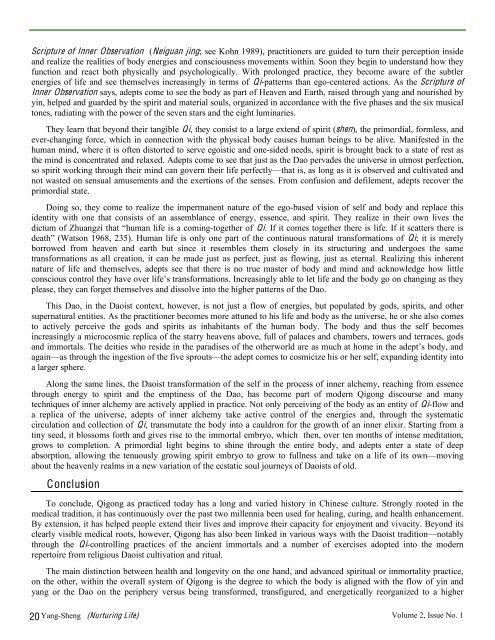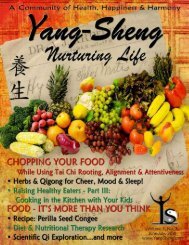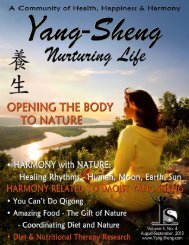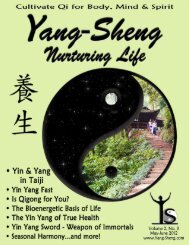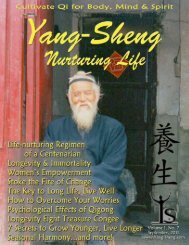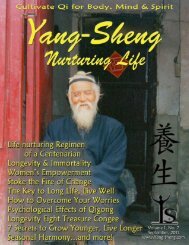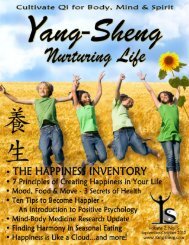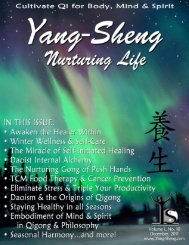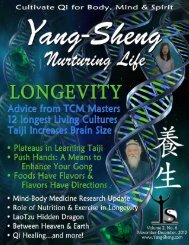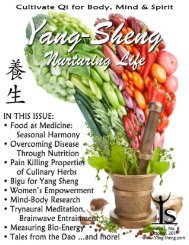Download PDF - Yang-Sheng
Download PDF - Yang-Sheng
Download PDF - Yang-Sheng
Create successful ePaper yourself
Turn your PDF publications into a flip-book with our unique Google optimized e-Paper software.
Scripture of Inner Observation (Neiguan jing; see Kohn 1989), practitioners are guided to turn their perception inside<br />
and realize the realities of body energies and consciousness movements within. Soon they begin to understand how they<br />
function and react both physically and psychologically. With prolonged practice, they become aware of the subtler<br />
energies of life and see themselves increasingly in terms of Qi-patterns than ego-centered actions. As the Scripture of<br />
Inner Observation says, adepts come to see the body as part of Heaven and Earth, raised through yang and nourished by<br />
yin, helped and guarded by the spirit and material souls, organized in accordance with the five phases and the six musical<br />
tones, radiating with the power of the seven stars and the eight luminaries.<br />
They learn that beyond their tangible Qi, they consist to a large extend of spirit (shen), the primordial, formless, and<br />
ever-changing force, which in connection with the physical body causes human beings to be alive. Manifested in the<br />
human mind, where it is often distorted to serve egoistic and one-sided needs, spirit is brought back to a state of rest as<br />
the mind is concentrated and relaxed. Adepts come to see that just as the Dao pervades the universe in utmost perfection,<br />
so spirit working through their mind can govern their life perfectly—that is, as long as it is observed and cultivated and<br />
not wasted on sensual amusements and the exertions of the senses. From confusion and defilement, adepts recover the<br />
primordial state.<br />
Doing so, they come to realize the impermanent nature of the ego-based vision of self and body and replace this<br />
identity with one that consists of an assemblance of energy, essence, and spirit. They realize in their own lives the<br />
dictum of Zhuangzi that “human life is a coming-together of Qi. If it comes together there is life. If it scatters there is<br />
death” (Watson 1968, 235). Human life is only one part of the continuous natural transformations of Qi; it is merely<br />
borrowed from heaven and earth but since it resembles them closely in its structuring and undergoes the same<br />
transformations as all creation, it can be made just as perfect, just as flowing, just as eternal. Realizing this inherent<br />
nature of life and themselves, adepts see that there is no true master of body and mind and acknowledge how little<br />
conscious control they have over life’s transformations. Increasingly able to let life and the body go on changing as they<br />
please, they can forget themselves and dissolve into the higher patterns of the Dao.<br />
This Dao, in the Daoist context, however, is not just a flow of energies, but populated by gods, spirits, and other<br />
supernatural entities. As the practitioner becomes more attuned to his life and body as the universe, he or she also comes<br />
to actively perceive the gods and spirits as inhabitants of the human body. The body and thus the self becomes<br />
increasingly a microcosmic replica of the starry heavens above, full of palaces and chambers, towers and terraces, gods<br />
and immortals. The deities who reside in the paradises of the otherworld are as much at home in the adept’s body, and<br />
again—as through the ingestion of the five sprouts—the adept comes to cosmicize his or her self, expanding identity into<br />
a larger sphere.<br />
Along the same lines, the Daoist transformation of the self in the process of inner alchemy, reaching from essence<br />
through energy to spirit and the emptiness of the Dao, has become part of modern Qigong discourse and many<br />
techniques of inner alchemy are actively applied in practice. Not only perceiving of the body as an entity of Qi-flow and<br />
a replica of the universe, adepts of inner alchemy take active control of the energies and, through the systematic<br />
circulation and collection of Qi, transmutate the body into a cauldron for the growth of an inner elixir. Starting from a<br />
tiny seed, it blossoms forth and gives rise to the immortal embryo, which then, over ten months of intense meditation,<br />
grows to completion. A primordial light begins to shine through the entire body, and adepts enter a state of deep<br />
absorption, allowing the tenuously growing spirit embryo to grow to fullness and take on a life of its own—moving<br />
about the heavenly realms in a new variation of the ecstatic soul journeys of Daoists of old.<br />
Conclusion<br />
To conclude, Qigong as practiced today has a long and varied history in Chinese culture. Strongly rooted in the<br />
medical tradition, it has continuously over the past two millennia been used for healing, curing, and health enhancement.<br />
By extension, it has helped people extend their lives and improve their capacity for enjoyment and vivacity. Beyond its<br />
clearly visible medical roots, however, Qigong has also been linked in various ways with the Daoist tradition—notably<br />
through the Qi-controlling practices of the ancient immortals and a number of exercises adopted into the modern<br />
repertoire from religious Daoist cultivation and ritual.<br />
The main distinction between health and longevity on the one hand, and advanced spiritual or immortality practice,<br />
on the other, within the overall system of Qigong is the degree to which the body is aligned with the flow of yin and<br />
yang or the Dao on the periphery versus being transformed, transfigured, and energetically reorganized to a higher<br />
20 <strong>Yang</strong>-<strong>Sheng</strong> (Nurturing Life) Volume 2, Issue No. 1


